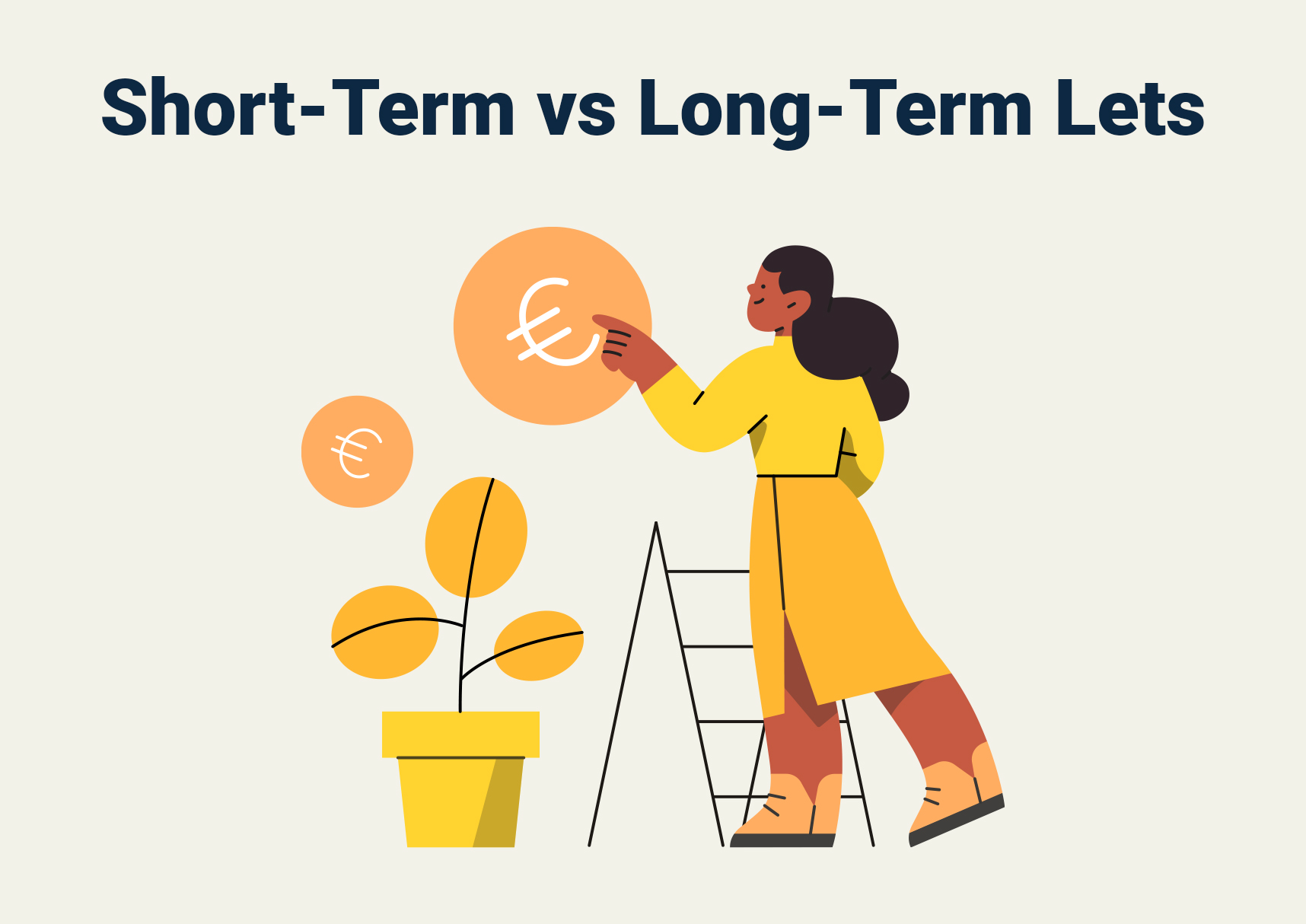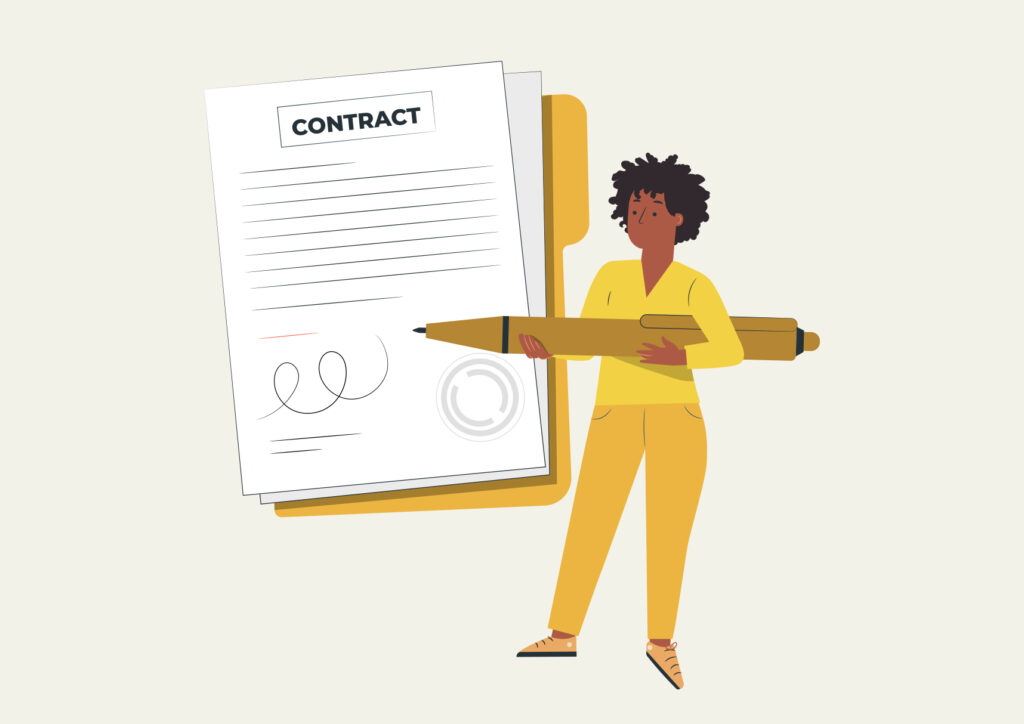Short-Term vs Long-Term Lets

If you’re a buy-to-let landlord weighing up short-term vs long-term lets, you may be wondering which tenancy agreement is right for you.
Whether you choose to let out your property for the short-term or long-term will depend on your circumstance, the location of your property, the time you have to spare and your investment goals.
When it comes to short-term vs long-term lets, there are positives and drawbacks to both. Making the right decision will come down to whether stability or flexibility are the most important aspects of your investment portfolio, as well as a number of other factors.
In this article, we take a closer look at long and short-term lets, the pros and cons of both, what you need to have in a short-term letting agreement as well as other information to help you decide which might be best for you and your property.
What is a Long-Term Let?
A long-term let is a fixed-term legally binding contract and is generally the standard model for many landlords renting out their property. Tenants are legally bound to the terms of the lease, including paying the rent over the contract period.
Long-term lets offer a range of benefits for both tenants and landlords, including the ability to establish a stable and mutually beneficial relationship over an extended period of time. But there are more nuances you should take into account. Read on to find out.
How Long is a Long-Term Let?
When it comes to short-term vs long term lets, one of the biggest differences is the length in landlord tenant agreements. A long-term lease typically has a tenancy period of 12 months, which can be renewed if both the landlord and tenant are happy to do so. While contracts may vary, some long-term lets have rolling agreements with tenants staying in the property for several years.
What are the Pros of Long-Term Lets?
Many investors prefer long-term lets because of a few key reasons:
Guaranteed Rental Income
Because a long-term let contract usually lasts for a year or more, landlords have a guaranteed income over the period. This can greatly help with cash flow, especially when it comes to paying mortgage fees and other costs associated with owning a property. It also allows those with buy-to-let mortgages to calculate their ROI more accurately, as their income is all but guaranteed to deliver money for the duration of the tenancy.
This goes both ways though, The tenants as well can enjoy the security of being able to stay in a property for a set period of time.
More Cost Effective
With a not-so-frequent turnover of tenants, especially if there’s trust between both parties, the maintenance costs of letting out a property are significantly lower. This can in turn help improve the landlord’s ROI as well as reduce the total cost of ownership.
Less Time and Effort
With a year-long contract it’s easier to set up the agreement and forget about it as long as monthly rent is being paid. Most tenants set up monthly direct debits to a landlord’s account so there are fewer things to worry about. This stability is attractive to many landlords, especially those who have multiple properties and want to keep the juggling that they have to do to a minimum.
What are the Drawbacks of long-Term Lets?
As goes for most things, long term letting agreements do have some drawbacks landlords should be aware of. That is to sat,they might not be ideal for all investors and landlords:
Less Flexibility
More financial stability offered with long-term lets comes with the drawback of less flexibility. This may make it difficult to break an agreement with a tenant, so you’ll need to have adequate break-clauses in the contract. Being locked into a longer-term agreement also means you may not be able to take advantage of rising rents in your area.
Not only that, but you may also end up with a problematic tenant. Even though there are laws that can protect you, they all take time to enforce. Time which may be of the essence to protecting both yourself and your investment property. Here, you may find more info about evicting tenants in the UK.
More Legal Obligations
As your property is a home for your tenants rather than a temporary accommodation there are a number of legal requirements you will need to adhere to. Most of these legal requirements are to ensure the property is safe and up to proper condition for tenants but you will need to be sure you are fulfilling your obligations. You are obliged to ensure your tenant’s deposit is safe in a government-approved deposit scheme. Additionally, an Energy Performance Certificate is a must. You will have to give a copy of it to every tenant.
As most landlords come to find out, there’s lots of red tape they need to deal with, especially when it comes to long-term letting agreements.
What is a Short Term Let?
Short-term lets are often used to describe contracts that don’t go over half a year in lenght. A short term-let provides a temporary home or accommodation to a tenant. This can be something like Airbnb, holiday lets, and corporate lettings, but can also be used for student accommodation or for people who need a property on a temporary basis. Such as tourists and visitors to a location or monthly rentals. With more people working remotely, many are choosing to base themselves in locations on a short-term basis and demand for short-term tenancy agreements are on the rise.
Short-term lets offer flexibility and convenience but may be more costly than long-term arrangements as they do require more from the landlord and are much higher in risk.
How Long Does a Short-Term Let Last?
A short-term tenancy is usually classified as one that lasts 6 months or less. Some range from a few weeks to a few months. For tenants, short-term lets are usually cheaper than a hotel and more comfortable. Additionally, they require far less commitment.
Short-term lets can be ideal for those who are looking for a temporary place to stay. These types of rentals often come with amenities such as fully-equipped kitchens. This makes them especially attractive to travelers or people on business trips.
What are the benefits of Short-Term Lets?
When looking at long-term vs short-term lets, short-term contracts can deliver many benefits to landlords that are willing to deal with a higher turnover of tenants and the additional work that may be required:
Higher Profits
Shorter tenancy agreements usually come with a slightly higher price tag for tenants. Compared to long-term tenancy agreements, landlords can sometimes achieve rents of 30% and higher with short-term lets.
Some properties in the right locations can earn 60% higher profits than long-term rents. On platforms like Airbnb, a property that would earn £1,000 as a long-term let can earn three times that amount as a short-term let – of course, this varies by location but there is big money to be made in short-term lets.
More Earning Opportunities
There’s also an opportunity to make more money by offering additional services. Such as housekeeping and laundry for your tenants. As they will be looking for a more comfortable stay in a shorter amount of time, especially if you’re renting out an Airbnb. This helps ensure that you’re getting the most out of your investment while still providing tenants with a reasonable deal.
While charging a premium is certainly an advantage that can deliver higher yields, it does come with less stability and requires more effort.
Increased Flexibility
With a short term rental agreement, it’s easier to swap out tenants. This comes in handy if some are causing your problems. If there is decent demand for short term tenancy agreements in your area, you can also be more selective about who you rent out your place to. Additionally, if you ever want to use the property yourself or have guests over, you don’t have to wait for a tenant to move out.
What are the Drawbacks of Short-Term Lets?
In the long-term vs short-term let debate, short-term lets do come with some drawbacks that landlords will need to consider. These include:
Additional costs
Short-term lets usually come with more work as well as more wear and tear to your property. A higher turnover of tenants may mean a higher likelihood of damage and the need to undertake repairs. As a short-term let landlord, you may also be responsible for bills that long-term tenants would usually take care of such as utilities, Wifi and TV licensing.
Additionally, short-term lets always come fully furnished. Meaning you’re responsible for both investing in decent furniture and taking care of any repairs or replacing anything that’s damaged beyond repair.
More Time and Effort
With a higher influx of tenants, it’s likely you’ll spend more time on a range of tasks. Such as: arranging people moving in and out, advertising the property and dealing with client problems or questions and queries about the property. Hiring a letting agency can help to reduce this workload, but will of course come at a cost.
Unstable Income
Short-term tenancies are more likely to come with periods of vacancy and income can be unpredictable. You need to consider the demand for short-term lets in your area. Whether there are going to be seasonal changes or long periods where no one is going to be living in the property. All of which can impact your margins.
FAQs
Do Short-Term Lets Include Bills?
Short-term lets typically come with bills such as wifi and utilities like water, gas and electricity included. So the tenant has everything included in the rent they pay each month. Despite bills coming included, as short-term lets typically command a higher rent, it’s easy for a landlord to cover these fees and still make a profit. Short-term tenants usually expect the home to be fully furnished and move-in ready. Including all the comforts of the home including linens, crockery and a fully equipped kitchen.
What is a Short-Term Letting Agreement?
Short term-lets are a different animal to the usual annual lease that comes with a long-term agreement. You may be wondering what a short term tenancy agreement includes.
A short-term letting agreement includes all of the details between tenant and landlord. Usually, it includes things like the following:
- Length of the tenancy – either a fixed term like six months or it may run on a weekly, monthly or quarterly basis.
- Rent – the agreement should specify the amount of rent a tenant needs to pay and how often it is due. The agreement should also outline details of the deposit.
- Tenants’ obligations – this details the responsibilities of the tenants. Such as what they are liable to pay for any upkeep of the property.
- Landlord obligations – repairs that you as a landlord are obliged to carry out. For example, gas and appliance safety checks and other factors to ensure the property is safe.
Do Long-Term Tenants Have Special Rights Over Short-Term Tenants?
There’s no big difference in a long-term tenant having “special rights” over short-term tenants. Tenants are held accountable to the rules and details set out in their tenancy agreements. They don’t automatically get something special because they are on a long-term rental lease.
When it comes to short-term vs long-term lets, both come with positives and negatives. Whether one is more suitable for you over the other will depend on your investment goals, the type of property and its location. As well as the time and effort you have to spare as well as your appetite for stability or flexibility. To find out more about the ins and outs of long-term vs short-term lets, get in touch with our team today.


